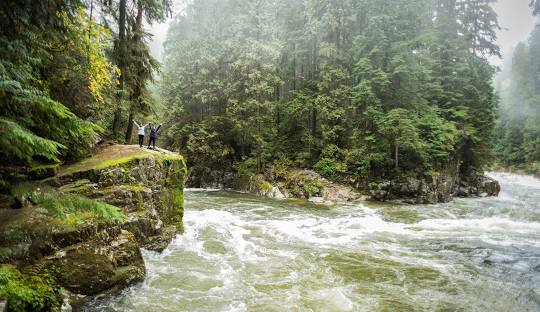The Capilano River, a striking and ecologically important waterway in British Columbia, winds its way through the North Shore Mountains before emptying into Burrard Inlet near West Vancouver. Spanning approximately 19 kilometers, this river plays a crucial role in supplying drinking water, supporting salmon populations, and offering recreational opportunities to residents and visitors alike.
Originating high in the rugged terrain near Capilano Mountain, the Capilano River flows southward, cutting through steep forested canyons and forming the heart of Capilano River Regional Park. One of the river’s most important features is the Cleveland Dam, constructed in 1954. This dam created the Capilano Reservoir, which is one of the main sources of drinking water for Metro Vancouver. The reservoir is strictly protected, and public access to its upper watershed is restricted to maintain water quality for nearly a million residents.
Just below the Cleveland Dam lies the Capilano River Hatchery, a key site for fish conservation in the region. The hatchery raises thousands of Chinook and Coho salmon every year, helping to maintain and replenish natural populations that migrate up and down the river. The facility is open to the public and offers educational displays and viewing windows where visitors can witness salmon jumping up fish ladders during the spawning season from May to November. This makes the hatchery not only an environmental resource but also a popular destination for tourists and families.
The surrounding Capilano River Regional Park is a haven for outdoor enthusiasts. Dense temperate rainforest lines the riverbanks, providing a scenic backdrop for a network of trails. One of the most popular routes is the Capilano Pacific Trail, which stretches from Ambleside Park at the river’s mouth to the Cleveland Dam. Along this trail, hikers and trail runners enjoy the peaceful sounds of the flowing river and occasional wildlife sightings. There are also shorter trails leading to viewpoints, picnic areas, and quiet corners for bird watching or photography.
Kayakers occasionally navigate the upper reaches of the Capilano River, although the fast-moving water and narrow canyon sections make it suitable only for experienced paddlers. Fishing is permitted in certain areas under strict regulations, mainly targeting salmon and trout, but always with conservation in mind. The river’s popularity as a recreation area is balanced by strong efforts to preserve its natural state and protect local wildlife.
The Capilano River is home to various animals, including black bears, coyotes, and numerous bird species. Conservation officers regularly patrol the area to enforce the BC Wildlife Act, especially during the summer and fall months when human-wildlife encounters become more common. Feeding wild animals is not only illegal but also dangerous. Habituated animals that lose their fear of humans can become aggressive, often leading to their relocation or euthanasia. Public education campaigns stress the importance of not leaving food or garbage in areas where animals can access it.
The cultural importance of the Capilano River runs deep. The name “Capilano” originates from Chief Joe Capilano, a respected leader of the Squamish Nation. For Indigenous communities in the region, the river and its surrounding lands are not just sources of water and food but hold spiritual and historical significance. These ties continue to be recognized in efforts to manage and protect the area in cooperation with First Nations groups.
Nearby attractions add to the river’s popularity. Just downstream, the privately operated Capilano Suspension Bridge Park draws hundreds of thousands of tourists each year with its treetop walkways and cliffside trails. Grouse Mountain, another nearby destination, offers skiing, hiking, and a gondola ride with stunning views of the city and the coast.
Despite the pressures of urban development and climate change, the Capilano River remains a vital artery for British Columbia’s environment, public health, and culture. Through careful management and community respect, this river continues to thrive as a natural and cultural landmark in the heart of the North Shore.

